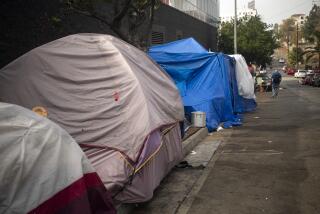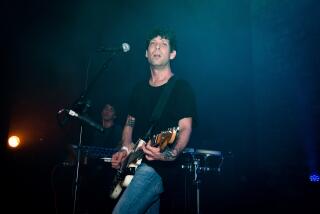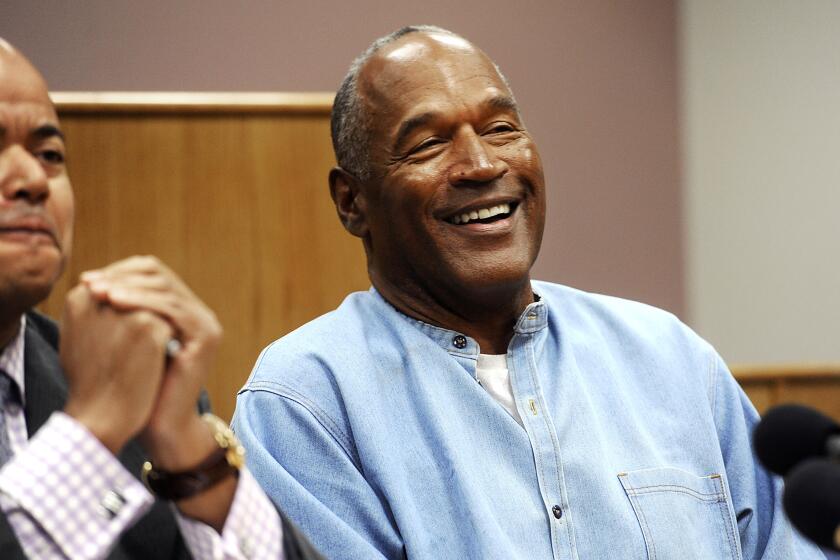A fatal toll on concertgoers as raves boost cities’ income
On the edge of the Mojave, music promoter Pasquale Rotella staged a rave about 11 years ago that ended with a coroner’s wagon rolling down desert roads.
Five people died of overdoses and drug-related car crashes during or shortly after the Nocturnal Wonderland concert at the Chemehuevi Indian Reservation in San Bernardino County.
The all-night party of electronic dance music was among the big raves to emerge from an Ecstasy-fueled underground of urban warehouses.
These days, raves fill fairgrounds, basketball arenas and football stadiums. Their audiences are no longer a few hundred revelers but tens of thousands.
As raves have moved into the mainstream, there have been more tragedies across the country.
Since 2006, at least 14 people who attended concerts produced by Rotella, considered within the industry the nation’s leading rave promoter, and Reza Gerami, another prominent Los Angeles-based impresario, have died from overdoses or in other drug-related incidents, a Times investigation has found.
GRAPHIC: Read more about the 14 deaths
According to an analysis of coroners’ and law enforcement reports from nine states, most of the deaths were linked to Ecstasy or similar designer drugs — hallucinogens tightly bound with raves.
Despite warnings of drug risks from law enforcement and health officials, the raves have received the blessing of local governments hungry for the revenue they deliver.
“It pretty well fills all the local hotels,” said Judge Dave Barkemeyer, who issued a permit for a Rotella rave in Milam County, Texas. “It brings in a fair amount of commerce.”
But with the revenue has come the risk of fatal overdoses.
Most of the dead were in their teens and early 20s, according to records. The youngest was 15-year-old Sasha Rodriguez, who overdosed at Rotella’s 2010 Electric Daisy Carnival at the Los Angeles Memorial Coliseum.
Scores of other drug-related medical emergencies and arrests were reported at some of the 64 concerts produced by Rotella or Gerami that were examined by The Times.
James Penman, the San Bernardino city attorney, said economics should never be a justification for raves. He long has urged officials to disallow the events at the National Orange Show Events Center there. Coroners’ reports show that two people have fatally overdosed at National Orange Show raves.
“The city should have zero tolerance for any activity where drugs are an integral part,” Penman said. “A rave without drugs is like a rodeo without horses. They don’t happen.”
::
Rotella’s firm, Insomniac Inc., and Gerami’s Go Ventures Inc., were among the first to bring raves to big-time venues and helped provide the model for other promoters around the country.
Rotella and Gerami are under indictment on bribery and other charges in connection with their raves at the Coliseum and adjoining Sports Arena. County prosecutors allege that the two conspired to keep a lid on their concert costs, such as expenses for security, by making about $2 million in illicit payments to a stadium manager. They have pleaded not guilty.
The son of Italian immigrants, Rotella grew up steeped in the music and break-dancing scene at Venice Beach near his family’s restaurant. He developed an interest in electronic music and created the Nocturnal Wonderland concert series when he was 19.
Gerami, whose family settled in Southern California after fleeing Iran’s Islamic Revolution, became a teenage record-spinner at the nightclub T.I.M.E. As DJ Reza, he was soon organizing raves across the Los Angeles area, including the Halloween-themed Monster Massive and a New Year’s Eve show called Encore.
As they followed separate paths into large arenas, Rotella and Gerami stopped using the word “rave” and billed their productions as “electronic music festivals.”
“There’s a big difference between an illegal and unsafe event and what we’re doing,” Gerami told The Times in 2000.
The Rotella and Gerami productions brought safety requirements that were missing from the underground scene. Their Coliseum contracts, for example, held the promoters responsible for the protection of rave attendees against injury.
Now-routine safety measures include security patrols, standby ambulances and medical stations. More recently, Rotella’s concerts have offered free water to attendees. Ecstasy overdose victims often crave water because the drug affects the part of the brain that regulates drinking behavior and body temperature. Insomniac’s website warns ticket buyers that they will be prosecuted if they use drugs at the concert.
Rotella and Gerami declined to be interviewed for this story. In a statement, Rotella’s firm said it does everything it can to protect concertgoers, but fans also must be responsible for their own actions: “Despite the fact that the overwhelming number of our festival’s hundreds of thousands of attendees have a positive experience, a small number of people make the personal decision to break the law as well as the policies of our events.”
Gerami said in an email that his concerts have always been “safe, secure and fun,” and that no deaths have occurred at or because of a Go Ventures production.
The coroners’ reports show that three people collapsed at raves produced or co-produced by Gerami’s firm due to overdoses and died later at a hospital. A fourth person died from multiple drug toxicity after returning home from a rave produced by Gerami and Rotella. According to a coroner’s report, friends said he had taken Ecstasy at the concert. The report also said he had heroin and cocaine in his system.
Some parents and concertgoers felt a greater sense of ease that the events were taking place in well-known venues. “It did make me more comfortable,” said John Johnson, whose son, Joshua, attended Insomniac’s Nocturnal Wonderland in San Bernardino in 2006.
Joshua, 18, overdosed on Ecstasy at the rave and later died. There was no news coverage or public notice taken of his death. “That made me feel very angry,” his father said, “and also a little hopeless about this situation, in terms of children and drug use and concerts.”
At the time, Rotella and Gerami were expanding their productions and the Coliseum’s governing commission was near the end of its failed pursuit of an NFL franchise. To pay the bills, the panel was increasingly turning to raves.
In 2007, Rotella brought the Electric Daisy Carnival to the historic stadium, selling 29,000 tickets, according to the commission. Attendance roughly doubled in each of the next two years, then reached 185,000 during a two-day stand in 2010. Gerami’s 2009 Monster Massive had 55,000 people jamming the turnstiles.
From 2006 to 2009, ticket sales tripled to more than 52,000 at a combined Insomniac-Go Ventures rave at the Sports Arena, Together as One.
A study prepared for Rotella’s company said the 2010 Electric Daisy Carnival pumped $42 million into the Los Angeles economy. Rotella and Gerami continued to maintain that the raves were safe.
After Sasha Rodriguez died in 2010, Rotella said in a television interview that her overdose was an isolated incident: “Last year was the only very tragic situation … the first. And we plan on it being our last.”
It was neither the first nor the last.
Before Sasha overdosed, four people had died after attending Coliseum and Sports Arena raves, and three died elsewhere, the coroners’ reports show. Six more deaths occurred during or shortly after subsequent raves in Nevada, Texas and Michigan. Rotella and Gerami put on all of the productions, together or separately.
In Sasha’s case, an insurance carrier for Rotella’s company paid her family $175,000 to settle a negligence lawsuit. The Insomniac insurance policy also covered the Coliseum’s liability. An insurer for the former Coliseum manager charged with taking bribes from Rotella paid the family a settlement of $15,000 because of his role in the 2010 rave.
::
Death by Ecstasy — a drug that enhances the effect of the beat-heavy music and pulsing lights of raves — can be torturous.
Michelle Lee, a UC Irvine student, was 20 when she went to the 2007 Monster Massive at the Sports Arena.
Marcus Gaede, who attended the concert, came upon Lee after she collapsed on an unlighted walkway. “She was really jittery,” he said. “Her words would get turned backward. She was really, really scared.”
According to the coroner, the Ecstasy in Lee’s system pushed her temperature to 108 degrees, shocked her liver and began destroying her kidneys and lungs. She died six days later.
As concerts like Monster Massive have become more popular, overdoses and other drug-related emergencies have soared, according to physicians and health officials — who said the problem is far worse than anything they see with rock shows or sports events.
Dr. Marc Futernick, medical director of emergency services at California Hospital Medical Center in Los Angeles, said teenagers and young adults on Ecstasy overwhelmed his emergency room when raves were held at the Coliseum or Sports Arena.
“It’s a nightmare, and it’s really sad to see,” he said.
There have been plenty of warnings.
A U.S. Centers for Disease Control and Prevention report in 2010 urged elected officials to closely scrutinize raves because of potential Ecstasy overdoses. It cited 19 overdoses, one fatal, involving an earlier Sports Arena rave co-produced by Rotella and Gerami.
Then-Los Angeles Deputy Police Chief Pat Gannon told Coliseum managers that the 2010 event would invite widespread Ecstasy use. Gannon, who retired last year, said, “Other events didn’t have the need for a massive amount of medical personnel or a quasi-emergency room, MASH unit in order to keep people safe.”
Gannon said the risks could be reduced somewhat by increasing security checks and restricting concerts to smaller, more-manageable arenas. Even those measures would fall short, he said, if promoters failed to convince concertgoers about the dangers of Ecstasy. “The promoters need to take responsibility,” he said.
But the lure of the events for local governments is strong.
Las Vegas cheered Rotella’s decision to move the Electric Daisy Carnival there from the Coliseum after Los Angeles officials withdrew their support. Then-Mayor Oscar Goodman saluted Rotella with a proclamation of Electric Daisy Carnival Week. A Rotella-commissioned survey said the 2012 concert injected $207 million into the Las Vegas economy and yielded $13.1 million in state and local taxes.
There were two drug-related deaths among people who attended last year’s Electric Daisy Carnival at the Las Vegas Motor Speedway, which the Pollstar concert trade publication said drew more than 320,000. Another concert is scheduled for the gambling capital in June.
Last summer, Rotella’s company cosponsored the four-day Electric Forest rave near Rothbury, Mich., where an audience of 25,000 filled campgrounds. One 37-year-old man died of heart inflammation and an overdose of oxycodone and amphetamine, according to a coroner’s report.
“It’s always sad when anyone passes away under those kinds of circumstances,” said Grant Township Supervisor Roger Schmidt, whose board approved the rave. “But as far as we could tell, there was no fault of the people sponsoring the event.”
Schmidt said the rave benefits the community on the whole: “It pretty much doubles the population of our county. So it’s quite an economic boost, really, for the community.”
But in some jurisdictions, the raves have not come back.
The state-run Cow Palace in Daly City, Calif., banned raves in 2010, the year two people died after overdosing on Ecstasy at a concert produced by Bay Area-based Skills DJ Workshop. “We just couldn’t implement enough procedures to give us enough assurance that there wouldn’t be a repeat,” said Joe Barkett, the Cow Palace chief executive.
The Electric Daisy Carnival did not return to Dallas after 2011, when two people died after taking drugs. A third person had died of an overdose the year before.
The Coliseum commission stopped allowing raves in 2011 after The Times reported that Insomniac had been making side payments to the stadium official overseeing the concerts.
Gerami’s productions waned after the scandal unfolded, but Rotella has kept a brisk schedule, holding 23 festival-sized events since March 2011, Insomniac’s website says.
Last May, he expanded into the New York metropolitan market, taking the Electric Daisy Carnival to New Jersey’s MetLife Stadium, home of the NFL’s Jets and Giants.
Insomniac made its Bay Area debut four months later, with a Beyond Wonderland rave at the O.co Coliseum in Oakland, where the Raiders football and A’s baseball teams play.
The Electric Daisy Carnival will make its first visit to the Greater Chicago area on the Memorial Day weekend. Tens of thousands of fans are expected at the Chicagoland Speedway.
Times staff writer Doug Smith contributed to this report.
More to Read
Start your day right
Sign up for Essential California for news, features and recommendations from the L.A. Times and beyond in your inbox six days a week.
You may occasionally receive promotional content from the Los Angeles Times.








